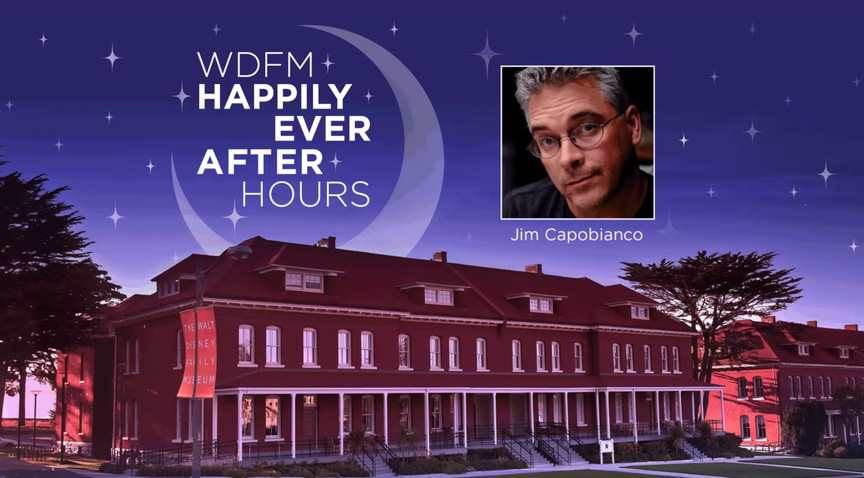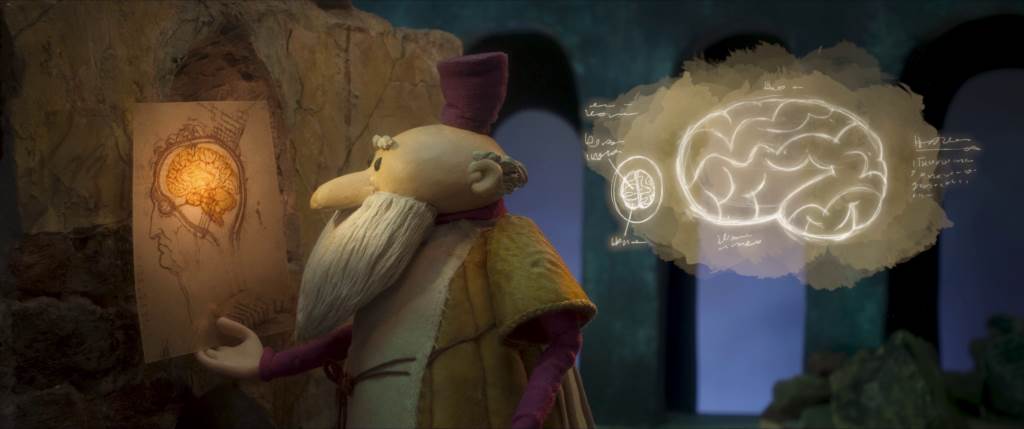The Walt Disney Family Museum’s Happily Ever After Hours virtual speaker series recently had Annie-winning and Oscar-nominated animator, writer, and director Jim Capobianco as a very special guest. His career has included work at Walt Disney Animation Studios, Pixar Animation Studios, and independent projects. Here are 10 things we learned from Jim Capobianco during his event.
1. Frank and Ollie made him want to become an animator.
“When I was sixteen or seventeen, I got a job at a bookstore and The Illusion of Life, Frank and Ollie’s book, came out… I sncathed that up and started reading about animation and that was around the time I started thinking I wanted to get into animation.” Back then, there were only two big animation studios to work at, Disney and Don Bluth. A graphic arts high school animation assignment led to his admission to CalArts. His first job out of college was an internship in England working on the Steven Spielberg/Don Bluth collaboration Fievel Goes West during the summer before he was hired by Disney.
2. He started at Disney on The Lion King.
“I was a trainee story artist on The Lion King,” Jim shared about his first job at Disney. “I was brought on and the first scene I did was the little mouse running on Scar’s hand.” He explained that the writers would give them a short description of what they wanted and the story artist’s would turn it into storyboards, injecting their own ideas and coming up with the dialogue. “The next one I did was I got a little paragraph and all it said was Simba’s just gotten out of the graveyard rescued by Mufasa, who’s really mad at him and he gives him a talk… I was like, what am I going to do with this? So I went to my mentor, who was Burny Mattinson… and he goes ‘Jim, calm down. Start with what you know.’ And that advice I’ve taken all through my career and I use it all the time.” He had the benefit of already seeing the storyboards for the scene where Mufasa appears in the clouds to talk to adult Simba and decided it would be powerful to mirror that. “I was researching and reading about African folklore and folktales and stuff and there are a lot of African tribes who believe that their ancestors are stars, so I thought let's put that in there and I pitched it to the directors and they were like, ‘Wow, this is fantastic.’” Jim said he had a lot of street cred at Disney after that moment.
3. He was the second person involved in Pixar’s Ratatouille.
Jim Capobianco left Disney to work with Pixar in the late 1990’s and was the second person assigned to a new film idea about a rat who cooks. “When I got on the project, Jan Pinkava was the director. He was the one who came up with this crazy outline. I was the second person brought onto the film as the Story Supervisor, so I would be the one running the Story department… He had laid out that it was a rat who cooks in Paris. I was like, how do we make a film out of this? It had three problems in the fact that it was about rats and most people don’t like them… It was about cooking, so how do you make that exciting?” When he started on the project, TV wasn’t full of cooking competition shows like it is today. “And then the third thing was that it took place in France, in Paris. And even though we all love France and Paris, this was the time of George W. Bush and Freedom Fries and we weren’t sure if Middle America would be interested in this kind of thing.”
4. Some of the chefs in Ratatouille were inspired by Anthony Bourdain.
Anthony Bourdain was one of the first popular TV chefs during the time or pre-production on Ratatouille and Jim Capobianco read his book as part of his research. “He described chefs as pirates and that stuck with me,” he shared about a solution to making the film’s cooking scenes exciting for the audience. He focused on the danger of the flames and knives flying around.
5. Receiving an Oscar nomination for Ratatouille.
Over the course of Ratatouille’s five years in development, there was a director change. “Eventually Brad Bird came on. He loved the film, he really loved what we were doing and was able to shape it into something.” The film was nominated for several Academy Awards, including best screenplay to Brad Bird, Jim Capobianco, and Jan Pinkava. “In the end, that film and the award nomination we received… is perfect because Jan was the conceptual genius of this whole thing, he came up with this crazy cockameme idea… None of us would’ve made that film on our own, so it’s really a testament to the collaboration of storytelling that the Disney and Pixar animation studios have.”
6. There’s a deleted concept from Ratatouille that he wished was left in.
“The one thing we built a lot as another story was the family,” Jim shared about Remy’s extended family that has a minor role in the final film. “We had this idea with the rat family that it’s a gang of heisting rats that would hang out outside of kitchens and would make these plans to rob these establishments. They wouldn’t go inside, but they would rob their garbage cans…. They all had different skills and it was fun to develop… Remy was really bad at it, he would be the lookout so he would be looking in kitchens and he would be distracted by how they cook and he wouldn’t see the guy bringing out trash cans.” Jim said fans can see more of this concept in The Art of Ratatouille and there’s even a few leftovers from this deleted subplot in the finished film. He felt like kids might have been more attracted to the film if it was left in.
7. Directing Your Friend, The Rat.
Jim got to direct the short film Your Friend, The Rat, which was Pixar’s first 2D short film. “What happened was Ratatouille was behind and all the resources were on the film and they needed something for the DVD short,” he shared. “I read a bunch of books about the history of rats and it was really fascinating.” After learning how rats have always traveled the world wherever humans go, he had an idea inspired by Disney’s past. “I thought this is a neat edutainment kind of short like Disney did in the ‘50’s… The film Your Friend, The Rat is actually a play on Our Friend, the Atom. I love those films and I always wanted to do something like that.” Since the CG artists were tied up finishing the film, he got the greenlight to make the short in 2D. “Teddy Newton, who oversaw the credit sequence, he wanted to do that in 2D and they had designed this really cool look for it… Because he was doing that, I was able to leverage what he was doing.” In the end, he was able to get a few CG animators to create bookends for the short and Brad Bird was a big fan of what he did.
8. It was hard to find hand-drawn animators to work on Mary Poppins Returns.
One of Jim’s projects after leaving Pixar was as the Animation Sequence Supervisor on Mary Poppins Returns. “When I was brought onto that, first, I didn’t know what kind of animation they wanted to do it in because the assumption is that people who don’t live and breathe animation and love the stuff are going to want to do it in CG animation,” he shared about the possibility for the 2018 sequel to Mary Poppins’ animated sequences. “When I first met with Rob [Marshall], he said ‘Let's look at the original piece,’ so we watched it and he said at the end, ‘What if, I don’t know if this might be crazy, but what if we did it in this flatter style?’” Jim was happy to hear that the director wanted to try and recreate the look of the original film. “As we developed it, we had to find an animation house that could animated it because, unfortunately, Disney Animation got rid of all the 2D stuff, desks, people… They ended up not wanting to do it or something, so we had to find a place. We lucked out in that we used Ken Duncan’s studio in Pasadena. Ken’s a Disney guy from when I was there… He just loves the traditional animation, so he and I, we reached out to everyone we knew and we tried to bring this team together…. It was tough because it’s a style that you want to get that looks like the ‘60’s animation style of Disney and not everybody can do that. We worked hard with them to try and get it to look that way.”
9. The penguins in Mary Poppins Returns almost got cut.
“Originally they had a minor role, very small, because they had a different sequence we were working on called the Anthropomorphic Zoo and they ended up being waiters in a cafe,” Jim shared. He explained that the film was originally to have three animated sequences and due to length, the decision was to cut one and Rob decided the zoo sequence was the one to go. “But then we lost the penguins. There was a moment where we walked all around the table with the directors and the songwriters and the writer and Rob was like, ‘Should we put the penguins in and what do we do?’ And took a vote because one of the things Rob wanted to do was he wanted it to be an homage to the original, but not take everything from the original and put it into this, so he was very cautious about that. He didn’t know if puting the penguins in was doing that or not. We all went around and everyone to a person said yeah, we should put the penguins in it… So we decided that they would be part of the dance troupe with Mary and kind of a chorus.”
10. He’s working on a stop-motion film about Leonardo Da Vinci called The Inventor.
“A While ago, I made a short film called Leonardo about Leonardo DaVinci and it’s done in hand-drawn animation and its about exploring Leonardo as a character, not just this supergenius untouchable savant of all knowledge but as a real person and find what he struggled with and how he moved through the world,” Jim shared about a short film that inspired his next feature film. “It took me ten-years to make that short and I never thought I would do anything with Leonardo again, but I guess he gets in your DNA, your blood. So I came up with this feature film about this time when he moved to France to work for the French King and I thought what an interesting time where he left Italy completely to go live the rest of his life.” Jim took a research trip, during which he discovered that King Francois I had a sister who was a patron of humanists and reformers. “We just actually announced today we’re going to have Stephen Fry voice Leonardo and Daisy Ridley… she’s going to voice Marguerite. It will be a combination of stop-motion animation because I love that form… and hand-drawn animation.” Production is scheduled to begin Summer of 2021 in France and a Kickstarter campaign will launch in July for fans to help fund the project.
Fans can see the full schedule of Walt Disney Family Museum virtual events, including the Happily Ever After Hours speaker series, at waltdisney.org/calendar.


